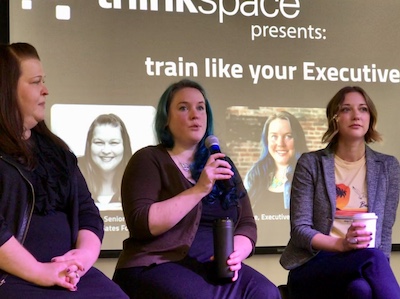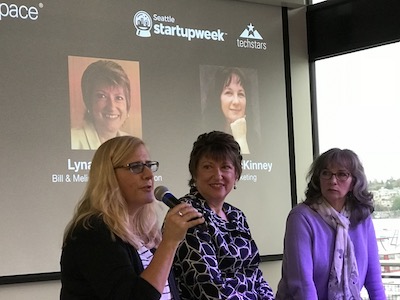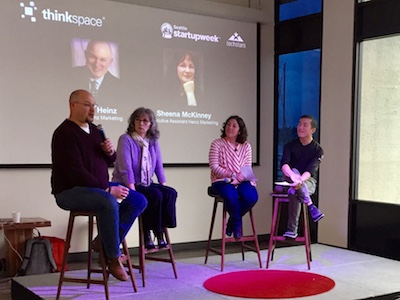
Seattle Startup Week is a week long celebration of entrepreneurship in Seattle. On October 9, 2018 we hosted an event that focused on Executive Assistants with panels of EA’s from small startups to large tech companies. Those in the field know an executive assistant is the unsung hero of the office who is running the show. Executive assistants spend countless hours anticipating the needs and supporting their bosses to make the CEO look good and of course to keep him or her organized. Though there are endless professional development and conference options for any given profession, executive assistants don’t have much to depend on in this arena. Peter Chee, CEO and founder of thinkspace, and his EA, Stephanie Slaton, decided to take on the task of bringing together EA’s from all over the Seattle area and create the opportunity for a shared learning experience.

The first two panels included amazing Executive Assistants from Amazon, Bill & Melinda Gates Foundation, Rover.com, Heinz Marketing, and Moz, and excitingly the final panel highlighted both the CEO and EA from Heinz Marketing, to capture how to best partner in this role.
We were able to transcribe Matt Heinz and Sheena McKinney’s responses to this final panel and have shared it below. Head over to the livestream links to all three of the panel discussions to hear more!
Video link to Panel 1 – Train Like the CEO/Executive That You Support
Video link to Panel 2 – Tips and Tools From the Best EA’s in Seattle
Video link to Panel 3 – How Best to Partner With Your EA

The last panel showcased Matt Heinz, CEO of Heinz Marketing and Sheena McKinney, Executive Assistant to Matt. It was great to see the two of them on stage together, interacting, and communicating. They have been working together for four and half years so it was good see what a well-oiled machine looks like. Below are some of the questions that we asked them starting with a lightning round of questions:
Interview Lightning Round:
What is your favorite guilty pleasure TV show?
Sheena: I watch a lot of HGTV and Food Network, but I must confess…. with emphasis on the word “guilty” vs. “favorite” … I watch The Bachelor. I know. It’s embarrassing. My own brother almost disowned me when he heard I watched the show.
What do you think about when you’re alone in your car?
Sheena: I’m pretty task oriented so I tend to think about things I need to do. I press the home button on my mounted-hands-free iPhone and tell Siri “add eggs to my groceries list” or “remind me tomorrow at 10 o’clock to update the spreadsheet”. I will also say– on the way to work I listen to the radio in my attempt to keep current and on the way home I listen to my book club books on Audible.
What is a hidden talent you have that has come in handy at work?
Sheena: I find writing comes easily for me. I’m able to send off emails without too much thought and occasionally I get to write blog posts for our blog.
Best Partnering Questions:
First, how long have you been working together? 4 ½ years
Matt, one of the key reasons Peter was hiring an EA was to open up time, 5 hours a week specifically. What are your top reasons for hiring an EA and how has hired Sheena changed the way you work?
Matt: Having a great executive assistant can make you literally 3-5X more productive than you can be on your own. It’s not just taking stuff off your plate, it’s delegating those things and having them done better, faster, smarter. And when I focus on the right things, it has an exponential impact on my business.
What are your work styles and how do you compliment one another?
Sheena:
-
- We are both zero inbox people. I’m so addicted to the freedom of this approach I’m also a zero-saved-texts person. Anything I might need from a text I copy/paste/save elsewhere. For sentimental conversations like a mushy note from my husband or a screen full of emojis from my granddaughter, I take a screenshot and save it to my photos.
- The way we approach tasks and information is very similar. Matt is a David Allen “Getting Things Done (GTD) guy and I originally learned the Franklin Covey system back in the early 1990’s (when Matt was about 14 years old— which makes me feel really old!). There are a lot of similarities, especially in GTD’s Five basic steps.
- I’m naturally more here/now minded and less future minded. Matt’s really good at short, mid, and long term planning and goals so I think we compliment each other here.
- I’m more detail oriented (not that Matt isn’t).
- I have perfectionistic tendencies… Matt is better and letting “Good” be “Good Enough”
- He works better in the morning, I work better in the afternoon
Matt: Before we hired Sheena, our HR consultant told me I needed to find someone who would take an assignment and think through the next 4-5 steps to get it done (vs me having to telegraph it). Sheena does that really well and isn’t afraid to come back to ask for further detail.
We also have our own hidden language of sorts. For example, I’ll reply to someone telling them I’m happy to grab an intro call with them and copy Sheena. Sheena knows that means a 30-minute call, knows when during the day to avoid scheduling it, etc. These levels of efficiency take time but they add to the extreme benefit of having an EA.
Expectations are important and communication is key. As the Executive Assistant, how do you set expectations with Matt? How does he set expectations with you?
Sheena: Yes, communication is key and we are in almost constant email communication. Our weekly 1:1 meeting is also a key way to set and communicate expectations. Sometimes, we’ll email each other prior to our meeting when the list is longer and/or needs some previous thought or research. Our annual review is really helpful in setting goals and areas of improvement.
How do you decide when it’s appropriate to use “short but sweet” communication vs. detailed communication?
The key word here is “decide” I naturally lean toward too much detail but I’ve learned to be as succinct and concise as possible at all times– because of whom I married and because most of the exec’s (current one included) strongly prefer “short but sweet”. I sometimes (literally) will reply to an email with “Short Story:……….and list the info. with bold fonts, underlines, highlights, etc. and below that, “Long Story:…. And then list out all the detail and back story… knowing full well he may not read it… but it makes me feel better and in some cases, if he questions the short answer… the longer one will help him understand why I arrived at my conclusion/decision.
How do you know when to solve a problem on your own or to ask for help?
Sheena: Plan A is to always try to solve the problem. 1.) I have self-sufficiency issues, 2.) It’s my job to gate keep and let Matt do what he does best. If it’s a completely new issue where I do not have previous experience from which to draw, I’ll ask for help… sometimes from one of our VP’s who has been around longer and knows Matt and our business better. If the outcome of the problem could negatively reflect on Matt and/or Heinz Marketing, I will ask for help because I/we care about integrity a lot and I’d rather be safe than sorry. Fortunately Matt is good and quick at making decisions and is so approachable I feel pretty free in asking when I do need to ask for help.
What have you found to be the most effective way to work together?
Sheena: Open, continual communication is key. I truly want feedback, the good, the bad, and the ugly. We’re both comfortable with fierce conversations. Also believing and assuming the best is important. Mutual respect and expressing appreciation is crucial. At a previous job I had no idea how I stood with my boss. It wasn’t until months into the job at the company Christmas party (and the alcohol was flowing) I found out from my co-workers how much my boss appreciated me and was glad he hired me. Matt does a great job of showing appreciation and confidence in me and that’s priceless.
We have startup founders and CEOs in the crowd today too, what advice can you give about how to hire and onboard your EA.
Matt: Do what I did, start the week by making a list of all the things you do that someone else could do for you. Next to that write how long it took. At the end of the day look at how many things and how much time is reflected, and consider the opportunity cost of what you could have spent that time doing. It won’t take you long to do the math and start the hiring process!